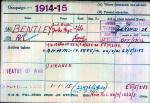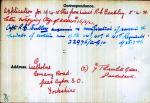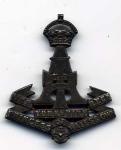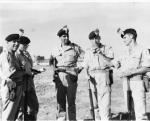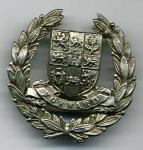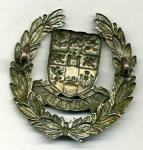-
Posts
5,308 -
Joined
-
Last visited
-
Days Won
5
Content Type
Profiles
Forums
Blogs
Gallery
Events
Store
Everything posted by leigh kitchen
-
Thank you, that's great - I'd come close to finding online WWI photos of Lt. Bentley, but could'nt quite get there. I'd found that he was commemorated at a "Queen's College" from, of all sites, "football24/7.com", a very animated forum which for some reason had a post listing all of the college's WWII casualties.
-
Yes Merv, there are some WWII, the usual War & Defence etc, a strip of ribbons including 39-445 Star, Africa (with 1st Army "1") & Italy Star ribbons, an Ipswich aluminium Coronation "souvenir" medal of 1902, officer's pips in cloth & metal, Pioneer Corps officer's OSD cap badge & collar dogs, & of course the WWI VM to a gunner, so looks like the medals / ribbons of at least two, maybe three different men.
-
MADRAS WAR CEMETERY, CHENNAI Madras War Cemetery is about 5 kilometres from the airport and 14 kilometres from the central railway station. The GST Road (Great Southern Trunk Road) leads from the airport past Trident Hotel to Kathipara roundabout. The way is via Mount Poonamall Road, passing at the foot of St. Thomas Mount. The cemetery can easily be located on the right hand side of the road 1 kilometre from St. Thomas Mount. From Madras Central Railway Station the route is up Mount Road (Anna Salai) and over the bridge which crosses the River Cooum. The route passes St. Mary's Cemetery on Pallawan Road and is via LIC building (Life Insurance Corporation Building) situated on Mount Road, which leads to Anna Flyover and to Kathipara Junction. MADRAS WAR CEMETERY was created to receive Second World War graves from many civil and cantonment cemeteries in the south and east of India where their permanent maintenance could not be assured. The cemetery contains 856 Commonwealth burials of the Second World War. The MADRAS 1914-1918 MEMORIAL is situated at the rear of the cemetery. It bears the names of more than 1,000 servicemen who died during the First World War who lie in many civil and cantonment cemeteries in various parts of India where it is not possible to maintain their graves in perpetuity. No. of Identified Casualties: 860
-
And sure enough, The Commonwealth War Graves Commision has: Name: BENTLEY, RONALD CAMERON Initials: R C Nationality: United Kingdom Rank: Captain Regiment/Service: Green Howards (Yorkshire Regiment) Unit Text: 2nd Bn. Age: 49 Date of Death: 25/08/1941 Service No: 46814 Additional information: Son of William Bentley, formerly Lord Mayor of York, and Ann Mary Bentley; husband of Francisca P. Bentley. B.A. Casualty Type: Commonwealth War Dead Grave/Memorial Reference: 1. E. 16. Cemetery: MADRAS WAR CEMETERY, CHENNAI
-
UK Army Roll of Honour Shows: Name: Ronald Bentley Given Initials: R C Rank: Captain Death Date: 25 Aug 1941 Number: 46814 Birth Place: York Residence: Yorkshire Regiment at Enlistment: Green Howards (Alexandra, Princess of Wales' Own Yorkshire Regiment) Branch at Enlistment: Infantry Theatre of War: India Regiment at Death: Green Howards (Alexandra, Princess of Wales' Own Yorkshire Regiment) Branch at Death: Infantry
-
A quick check shows that there was a Captain Ronald Cameron of 2nd Battalion The Yorkshire Regiment who qualified for The 1924-15 Star, entering Theatre of War "1" (France) on 1/1/1915. In 1920 he appears to have been living in Yorkshire in 1920, when he applied for his Star, & in Sunderland in 1921. I'm having trouble with this entry on the back of the MIC & don't know if I'm reading it correctly - "Capt R. C. Bentley enquiries verification of service & medals of certain men of the 24th, 40th, & 41st Regiments of 25.7.26 22976/A.G. 10". The 24th Foot became The South Wales Borderers, The 40th The South Lancs & The 41st The Welsh Regiment. I must be reading this entry on the MIC wrong. A photograph in the Outpost Office of the 2nd Battalion Yorkshire Regiment (the Green Howards) in Trnity Church, Richmond shows 26 officers. Of the 26 officers photographed in October 1914, 10 were dead by the end of the year - Bentley landed in France to join the battalion on 1st January 1915. 3 more of the officers in the photo were killed subsequently, 10 wounded and/or taken prisoner, & only 3 appear to have survived the War unscathed.
-
It's interesting that these brassards appear to still be a kind of "general issue" for military & police in UN missions, along with the beret, loose UN patches, cravat, blue armband with UNH insignia & sometimes a mission-specific embroidered title.
-
The "exemplary etc " gradings sound like the army gradings (I don't know if they still grade). I actually received my police certificate about a week ago - 6 years late. The only reason I wanted it was because when I retired I submitted the printed request for a reference - nuthin' happened. Nobody noticed I'd retired, to the extent of not paying me my pension. Some while later after I'd raised the pension issue I got a 'phone call asking me if I wanted an inscribed clock, decanter or whatever presented to me - I said I did'nt, I'd like the reference though - nuthin' happened. I finally decided to ask for one again simply in terms of job applications & apparently what you get nowadays is a mock vellum certificate that just states you served for whatever period you served for. Not something I wanted, but it's the closest thing you get to a reference. The doing away with gradings would have had a lot to do with the risk of legal action & the like? Demands to know why somebody got an exempary while somebody else got a blank & that sort of thing?
-
I've got one of those medals, I wondered what it was. I suppose there was a clue in that I got it in Bosnia.......
-
Old brass oil bottles were still turning up with SLRs in the 1970's - that's how I got a couple of mine.
-
A badge of The London & North Eastern Railway Police, formed in 1921 when the 1921 Railways Act amalgamated over one hundred separate railway systems, about 20 of which had police forces. On 1/1/1949 they became part of The Transport Commission Police. This badge was identified for me a couple of days ago, (thanks to peter4447 & daverpol of The British & Commonwealth Military Badge Forum)it’s of white metal with what appear to be small traces of chrome on the reverse & on the lugs. It was worn by Inspectors & above, in white metal until 1936 & then in chrome finish until 1949. The 1921 Railways Act formed four groups of railways: The Great Western Railway (G.W.R.) The London and North Eastern Railway (L.N.E.R.) The London, Midland and Scottish Railway (L.M.S.) The Southern Railway (S.R.) Each of these had its own police force, each with its own Chief of Police, divided into Divisions under a Superintendent, & then into Posts under an Inspector. Duties not normally thought of as police duties were retained, personnel acting as crossing keepers etc. The LNER was formed from: The Great Eastern Railway The Great Central Railway The Great Northern Railway The Great North of Scotland Railway The Hull and Barnsley Railway The North British Railway The North Eastern Railways The North Eastern Railway was the largest and most successful of these, all of which had their own police forces. The LNER Police was one of the largest Police Forces in the Country. Its Headquarters was at York, its three Areas; North-Eastern, Scottish and Southern, were split into Divisions headed by a Superintendent. NORTH EASTERN AREA (Headquarters at Newcastle) Northern Division Newcastle (Divisional HQ) Sunderland West Hartlepool Southern Division York (Divisional Headquarters) Darlington Middlesbrough Leeds Eastern Division Hull (Divisional HQ) SCOTTISH AREA (Headquarters at Edinburgh) Scottish Division Edinburgh Glasgow Dundee Dunfirmline SOUTHERN AREA (Headquarters at Wellers Court, Pancras Road, London NW1.) London Division Kings Cross (Divisional HQ) Farringdon Street Marylebone Liverpool Street Bishopsgate Stratford Sheffield Division Sheffield (Divisional HQ) Manchester Bradford Nottingham Leicester Grimsby Division Grimsby (Divisional HQ) Grimsby Docks Doncaster Peterborough Cambridge Division Cambridge (Divisonal HQ) Ipswich Norwich Parkeston Quay In 1935 the establishments of these forces were increased. The LNER Police recruits were trained at other forces training schools, most other forces issued a Manual of Guidance to their recruits & expected them to train & study in their own time. The Southern Railway transferred existing employees into their police on secondment & appointed them if found to be suitable, The L.M.S. preferred ex-servicemen. On 1st January 1949 the British Transport Commission Police were created from the railway police forces, canal police and minor dock forces, commanded by the Chief Officer (Police) British Transport Commission & consisting of six areas each led by a Chief of Police. With an establishment of 3,890, The B.T.C. Police was the second largest police force in the country. Also in 1949 The Transport Act 1949 repealed legislation relating to the Railway Police and BTC Police were appointed under Section 53 of the Act. In 1962 The British Transport Commission was abolished & since that date the force has been The British Transport Police. Over the years B.T.C.P. & B.T.P. survived despite various cost cutting measures involving their proposed disbandment or splitting into smaller forces being considered, their pay & conditions have lapsed behind those of other police forces at times to such an extent that they lost hundreds of officers to other forces, but they survive today.
-

BEM group question!
leigh kitchen replied to paddywhack's topic in Great Britain: Orders, Gallantry, Campaign Medals
I have a vague recollection from the 1970's of sergeants / staff sergeants being awarded BEMs following extended periods of acting in an officer's role, as platoon commanders and the like. -

New British finds
leigh kitchen replied to CRBeery's topic in Great Britain: Orders, Gallantry, Campaign Medals
John Traynor's Medal Index Card has his name corrected from "Trayhar" His date of entry into theatre of war is written as 13/10/22, unfortunately the theatre is'nt stated. A Dublin address is noted on the back of the card, looks like " C/O Fleming, 58 Sumnerhill Dublin". -
Some collectors (including me) tend to refer to this "flat-topped" Victorian Crown as "The Jubilee Crown", others as "The Cavalry Crown" because they associate its use with cavalry regiment's badges - perhaps thinking of regiments such as 21st Lancers were formed originally as The 3rd Bengal European Light Cavalry & were later The 21st (Empress of India's) Lancers. Offhand I can only think of The DLI & HLI who wore the crown on their Victorian era badges. Possibly tThe Hampshire Regiment on some insoignia? I suppose we should put a thread together on the badges with this crown.


